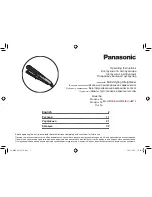
4
5
Filling the water tank
WARNING:
Make sure that the iron voltage
(see name plate ) and the mains voltage
match.. [Fig. 6] .
Damage resulting from incorrect voltage
selection will not be covered by warranty.
• Pull the handle to the high position directly,
no need to press the button;
• Check that the plug is disconnected from the
socket.
• Turn the temperature dial to “
” [Fig. 1].
• Open the water inlet (2).
• Raise the tip of the iron to help the water
enter the opening without overflowing.
• Slowly pour the water into the reservoir using
the special measure and taking care not to
overfill the water tank (about 35 ml) [Fig. 2}.
• Close the lid (2).
Selecting the temperature
• Put the iron in a vertical position.
• Cut the plug in the socket.
• The iron soleplate temperature is increased
by turning the temperature dial in any set you
want.
• Wait a moment until the light goes off, then
the iron is heating [Fig. 1].
Selecting Shot of steam
Press the shot of steam button (1) to generate a
powerful burst of steam that can penetrate the
fabrics and smooth the most difficult and tough
creases. Wait for a few seconds before pressing
again.
Warning:
the shot of steam function can
only be used at high temperatures. Stop the
emission when the plate temperature control
light (6) comes on, then start ironing again only
after the light has gone off.
Steam Ironing
Care And Cleaning
Please note: before cleaning the iron in any
way, make sure that the appliance plug is not
connected to the socket.
Any deposits, starch residue or size left on the
plate can be removed using a damp cloth or an
unabrasive liquid detergent.
Avoid scratching the plate with steel wool or
metallic objects.
The plastic parts can be cleaned with a damp
cloth then wiped over with a dry cloth.
mp cloth and wipe dry.
Dry Ironing
To iron without steam.
Warning:
for delicate fabrics, we recommend moistening the fabric beforehand putting a damp
cloth between the iron and the fabric. To avoid staining.
Storage
• Disconnect the plug of the iron from the
socket.
• Empty the reservoir by turning the iron upside
down and gently shaking it. [Fig. 3]
• Leave the iron to cool down completely.
• Roll up the power cord
• Press the folding button (3) and turn the
handle to the low position.[Fig. 5].
• Always put the iron away in a vertical position.
Ironing Tips
We recommend using the lowest temperatures
with fabrics that have unusual finishes
(sequins, embroidery, flush, etc.).
If the fabric is mixed (e.g. 40% cotton 60%
synthetics), set the thermostat to the
temperature of the fibre requiring the lower
temperature.
If you don’t know the composition of the fabric,
determine the suitable temperature by testing
on a hidden corner of the garment. Start with a
low temperature and increase it gradually until
it reaches the ideal temperature.
Never iron areas with traces of perspiration
or other marks: the heat of the plate fixes the
stains on the fabric, making them irremovable.
The size is more effective if you use a dry
iron at a moderate temperature: excess heat
scorches it with the risk of forming a yellow
mark.
To avoid marking silk, woolen or synthetic
garments shiny, iron them inside out.
To avoid marking velvet garments shiny, iron
in one direction (following the fibre) and do not
press down on the iron.
The heavier the washing machine is loaded,
the more garments come out creased. This
also happens when the spin-drying revolutions
are very high.
Many fabrics are easier to iron if they are not
completely dry.
For example, silk should always be ironed
damp.
























